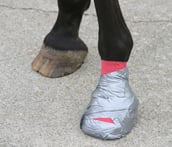 With the constant changes of weather - warm to cold, wet to dry - it's a common time for horses to come up lame with a hoof abscess. A hoof abscess is a localized bacterial infection in the sensitive structures of the hoof, typically in the front feet. Typical signs of a hoof abscess include sudden and severe lameness and pain. The horse bears little to no weight on the leg with the abscess or may walk on its toe. Most abscesses are found in the sole of the hoof, but an abscess can be found elsewhere. Other signs include heat in the limb or hoof, an increased digital pulse, and can include a swollen leg and/or a low-grade fever. The tendons in the affected leg can become painful and swollen due to congestion of blood vessels.
With the constant changes of weather - warm to cold, wet to dry - it's a common time for horses to come up lame with a hoof abscess. A hoof abscess is a localized bacterial infection in the sensitive structures of the hoof, typically in the front feet. Typical signs of a hoof abscess include sudden and severe lameness and pain. The horse bears little to no weight on the leg with the abscess or may walk on its toe. Most abscesses are found in the sole of the hoof, but an abscess can be found elsewhere. Other signs include heat in the limb or hoof, an increased digital pulse, and can include a swollen leg and/or a low-grade fever. The tendons in the affected leg can become painful and swollen due to congestion of blood vessels.
Purulent fluid (commonly called “pus”) is produced as a reaction by the horse’s body to the infection. The pus accumulates between the keratinized and germinal layers of the hoof wall. Since the hoof cannot expand, the increased pressure of pus collecting within the hoof capsule causes significant pain. As the abscess progresses, the infection and pressure of purulent fluid (pus) accumulation in the hoof often cause severe pain until the infection works its way up the hoof wall and pops out at the coronary band, or the bulb of the heel or drains out the sole.
A hoof abscess can be diagnosed by examining the hoof for heat and pain, swelling in the pastern and fetlock and by the presence of a pronounced digital arterial pulse. If the horse is shod, the shoe is removed and the hoof cleaned. Hoof testers are often used to test the horses’ sensitivity to pressure in specific areas of the hoof to locate the point of origin.
A hoof abscess can be caused by a sharp object penetrating the sole of the hoof (such as a nail), damage to the corium from decreased blood flow, or by bacteria migrating in to the defects, fissures and cracks in the white line. Sole penetration by a sharp object is not a very common scenario for a hoof abscess. More often, an abscess is a result of corium or lateral cartilage area compression or most frequently due to the introduction of bacteria and moisture in to the hoof.
If the abscess is caused by bacteria in to hoof from the outside, a particle of sand or soil enters the softer white line area and becomes engrained in the sensitive lamina underneath the hoof wall, resulting in an infection inside the hoof. The infection can travel up the hoof and drain at the coronary band or stay close to the sole of the hoof. An abscess can also occur under the bars of the hoof.
The infection can also enter as a result of a nail driven too close to the white line, a hoof wall defect or hoof separation. Horses that have been shod and then go barefoot tend to have an increased chance of developing a hoof abscess until the hoof becomes stronger.
While a hoof abscess can heal on its own, this is not recommended. An abscess can be extremely painful for the horse and the healing process will take significantly longer without intervention. It is recommended that you work with your veterinarian and/or farrier to diagnose and treat an abscess. If the horse is shod, the shoe is normally pulled. The hoof is then thoroughly cleaned and hoof testers can be used to help locate the point of entry and better determine the location of the abscess.
Often a black line is identified and the line is followed to locate the infected area. Using a hoof knife or loop knife, your veterinarian will make a very small hole in the sole of the hoof to allow for drainage and provide relief of the pressurized fluid. When the pressure built up by the trapped pus is released from the hoof capsule, often a black or brown fluid will drain from the site and the horse will experience some relief immediately.
If the point of origin and the abscess cannot be identified or the infection is too deep in the hoof, (the abscess could be deep in the heel/frog/bars region), no cutting or holes will be made. Cutting too much or going too deep can be more harmful than beneficial to treatment. If a drain hole is not able to be made or cannot sufficiently drain the abscess, then most likely the abscess will progress up to the coronary band and the pus will drain there.
 Whether a hole is made or not, it is important to keep the hoof as clean and protected as possible and to apply a poultice. A standard recommended protocol for treatment begins with Epsom salt added to water and soaking your horse’s hoof in a shallow pan, bucket or soaking boot for 15 minutes 2 times/day. The soaking will "draw" the abscess, pulling the bacterial infection from the hoof. If no hole is made, the poultice can help soften the sole. If a drain hole is made in the hoof, then it is imperative that the hole be protected and kept clean while the abscess drains and the hoof heals.
Whether a hole is made or not, it is important to keep the hoof as clean and protected as possible and to apply a poultice. A standard recommended protocol for treatment begins with Epsom salt added to water and soaking your horse’s hoof in a shallow pan, bucket or soaking boot for 15 minutes 2 times/day. The soaking will "draw" the abscess, pulling the bacterial infection from the hoof. If no hole is made, the poultice can help soften the sole. If a drain hole is made in the hoof, then it is imperative that the hole be protected and kept clean while the abscess drains and the hoof heals.
The hoof is then wrapped to help cushion and protect the hoof to ensure that dirt and manure cannot come in contact with the hole and sensitive tissues. Creating a “pad” by using a plastic baby diaper and attaching it with duct tape (both waterproof) can help keep the area clean and dry.
To help lessen the chances of your horse having a hoof abscess, maintain a regular schedule with your farrier or trim your horse on a regular basis. Often hooves with too much toe or excessive bars are more prone to hoof abscesses.
With proper treatment, hoof abscesses are no fun for you or your horse, but not dangerous.



